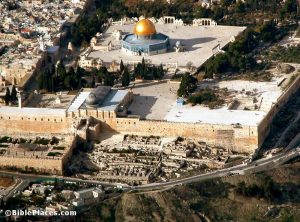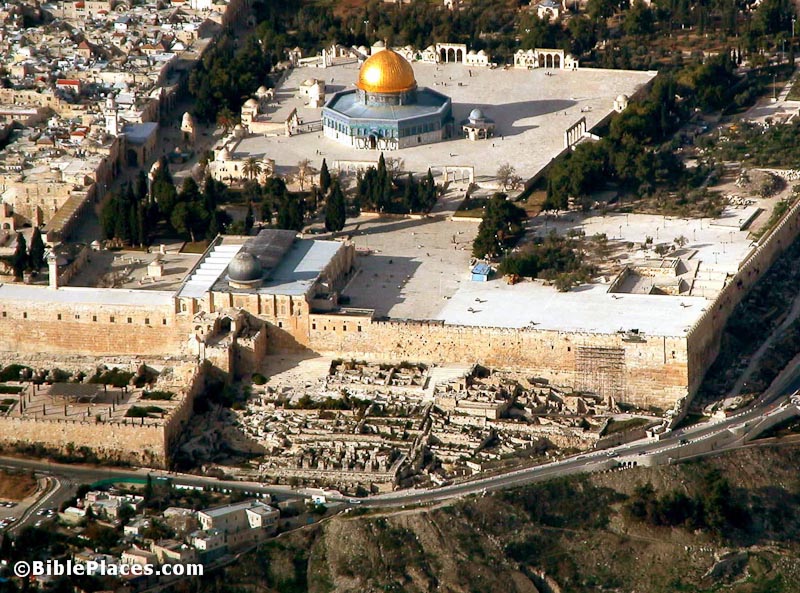Based on archaeological excavations near the southern wall of the temple, the research of Shmuel Safrai, and a nuance of the Hebrew verb that is one of the equivalents for Greek ἐκβάλλειν (ekballein; drive out, banish; throw out; throw away, reject; cast out of a place, expel; remove, get rid of; put out), it may be necessary to reinterpret the gospel accounts of Jesus’ “cleansing” of the temple (Matt. 21:12-13; Mark 11:15-17; Luke 19:45-46; John 2:13-16), even suggesting a different location for Jesus’ action.“And he entered the temple and began to drive out those who sold.” (Luke 19:45; RSV)
On the face of it, εἰσελθεῖν εἰς τὸ ἱερόν (eiselthein eis to hieron; Matt. 21:12; Mark 11:15; Luke 19:45) should mean “enter [one of the courts of] the temple,” perhaps the outer court, the Court of the Gentiles. However, since monetary transactions and other commercial activities were not permitted in the temple—not even in the Court of the Gentiles, into which non-Jews were allowed to go—in this context, “temple” probably refers to the area surrounding the temple platform, particularly the area immediately south of the Huldah Gates, those monumental gates that served as the entrance and exit for temple pilgrims. In rabbinic sources this area, or even the whole of Jerusalem, could be called “the temple.”[10] True, the Greek ekballein can mean “drive out”; but assuming the vendors and money changers conducted their business outside the temple, “drive out” is puzzling.

In this aerial view of the temple mount from the south, almost the whole of the mount’s southern support wall is visible. South of this ancient retaining wall excavations were conducted beginning in 1968. In these excavations, archaeologist discovered scores of mikva’ot. Photograph by Todd Bolen. Photo © BiblePlaces.com
Although not the most common Hebrew equivalent for ekballein, Robert L. Lindsey suggested that the Hebrew verb הוֹצִיא (hotsi; take out, bring out) underlies ekballein. If so, then ekballein might not imply violence, but only have the sense “take aside” or “pull off to the side”: Inviting the temple merchants out of their shops, Jesus took them aside (or, took them out of the area) to rebuke them. Jesus may not have used force, but rather castigated the sellers by skillfully combining texts of Scripture: “‘My house is a house of prayer’ [Isa 56:7], but you have turned it into ‘a den of thieves’ [Jer. 7:11].”
Premium Members and Friends of JP must be signed in to view this content.
If you are not a Premium Member or Friend, please consider registering. Prices start at $5/month if paid annually, with other options for monthly and quarterly and more: Sign Up For Premium
- [1] See BAG, 236-237; Jastrow, 587-588. ↩
- [2] Notice this same pattern of increasing violence (from Luke to Mark to Matthew) in the Markan and Matthean parallels to Luke 21:12-13: “They will lay their hands on you and persecute you, delivering you up to the synagogues and prisons, and you will be brought before kings and governors for my name’s sake.” Mark's parallel reads, “They will deliver you up to councils; and you will be beaten in synagogues; and you will stand before governors and kings for my sake” (Mark 13:9). Matthew’s parallel reads, “They will deliver you up to councils, and flog you in their synagogues, and you will be dragged before governors and kings for my sake” (Matt. 24:17-18). See R. Steven Notley, “Anti-Jewish Tendencies in the Synoptic Gospels,” Jerusalem Perspective 51 [1996]: 23. ↩
- [3] Joseph A. Fitzmyer, The Gospel According to Luke (AB 28A and 28B; Garden City: Doubleday, 1981-1985), 1264. ↩
- [4] Matthew was apparently unwilling to copy Mark’s “He would not allow anyone to carry anything through the temple” (vs. 16). With the addition of “in the temple” (in the phrase, “those who sold and those who bought in the temple” [vs. 15], which Matthew copied) and “through the temple” (vs. 16), Mark created the impression that temple commerce took place within the temple itself rather than outside the temple. ↩
- [5] See Notley, “Anti-Jewish Tendencies in the Synoptic Gospels”: 25-6. ↩
- [6] For a description of Jesus’ sophistication in handling Scripture, see Joseph Frankovic, “Remember Shiloh!” Jerusalem Perspective 46-47 (1994): 24-31. ↩
- [7] When Jesus mentioned “robbers,” he was, perhaps, alluding to the whole of Jeremiah 7 (cf. especially, vss. 14, 20, 30, 32-4). ↩
- [8] See Menahem Stern, “Aspects of Jewish Society: The Priesthood and Other Classes,” in The Jewish People in the First Century [ed. Shmuel Safrai and Menahem Stern; Amsterdam: Van Gorcum, 1976], 600-12. See also Stern, “The Reign of Herod and the Herodian Dynasty,” in The Jewish People in the First Century, 273-4. ↩
- [9] Members of these high priestly dynasties stopped at nothing to achieve their aims: “Now the high priest Ananias was advancing day by day in prestige and was being ever more lauded and honored by the citizens. For he was a ‘supplier’ [ποριστικός] of money. Indeed, every day he was treating the high priest [Jesus son of Damnaeus, Josephus, Antiq. 20.203] and Procurator Albinus to gifts. In addition, he had slaves, utterly depraved, who joined forces with the most insolent men. They would go to the threshing floors and take the tithes meant for the priests by force and beat any who resisted. The high priests were practicing the same things as their slaves and no one could restrain them. As a result of this, it happened that some of the priests who had formerly been fed from the tithes died for lack of food” [Josephus, Antiq. 20.205-207]; trans. Buth-Kvasnica; see Randall Buth and Brian Kvasnica, “Temple Authorities and Tithe Evasion: The Linguistic Background and Impact of the Parable of ‘The Vineyard, the Tenants and the Son,’” in Jesus’ Last Week: Jerusalem Studies in the Synoptic Gospels, Volume 1 [ed. R. Steven Notley, M. Turnage and B. Becker; Leiden: E. J. Brill, 2005], 69. Cf. Antiq. 20.181). The appalling portrait of the high priestly families (especially, the houses of Boethus, Hanan, Kathros and Phiabi) painted by Josephus is confirmed by rabbinic sources: “Abba Saul ben Bothnith said in the name of Abba Joseph ben Hanan: ‘Woe is me because of the house of Boethus; woe is me because of their staves. Woe is me because of the house of Hanan; woe is me because of their whisperings [i.e., informing to the civil authorities, apparently]. Woe is me because of the house of Kathros; woe is me because of their pens [H. Freedman’s note in Soncino English version: “With which they wrote their evil decrees.”]. Woe is me because of the house of Ishmael ben Phiabi; woe is me because of their fists. For they are high priests, and their sons are [temple] treasurers, and their sons-in-law are trustees, and their servants beat the people with staves’” (t. Menahot 13:21; b. Pesahim 57a). ↩
- [10] The “temple” was not only the temple proper; but also the temple complex, including its commercial areas. Even Jerusalem is sometimes called “the temple” in Jewish sources: “As time passed, the Rabbis taught that the sanctity of the temple applied, in great degree, to the entire city of Jerusalem” (Shmuel Safrai, “Early Testimonies in the New Testament of Laws and Practices Relating to Pilgrimage and Passover”: 8-9 [forthcoming]). ↩




Comments 1
The irony of the reality of priestly corruption (Sadducees who believed only in money) was that it was facilitated by and dependent on the Pharisee’s scruples of law-keeping, including the tithe. The high priests were raking in close to 10% of the Israeli GDP solely due to the widespread zeal for the law, taught and enforced by the Pharisees. And this after a long era – 500 years – in which the temple had been entirely devoid of both the Ark of the Covenant and God’s presence dwelling between the non-existent cherubim. This was an open secret in Israel, certainly since Pompeii entered the Holy of Holies and came out saying “Wait a minute, this place is completely empty”. The rituals of Yom Kippur had been a farcical exercise in charades, with the so-called High Priest entering and exiting a Holy of Holies that was totally empty, pretending to do something extremely important (it was, but only in sustaining his family business). And then one day the Parochet was torn from top to bottom, finally exposing for all to see the emptiness and futility of the whole exercise. Not for nothing did Jesus himself refer to the temple only as a “house of prayer for all people”, and not a focus of divinely-appointed sacrifice. From God’s and Jesus’ point of view, the real business at the temple was being conducted by godly people in its various courts, as the book of Act abundantly shows.